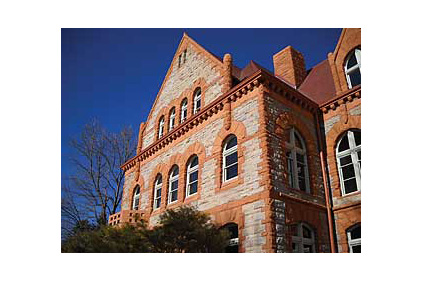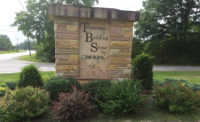
Historic Treat Hall on the campus of Johnson & Wales University in Denver,
CO, recently experienced a revitalization, as its sandstone exterior was
restored by experts at Building Restoration Specialties, Inc. (BRS) of Denver,
CO. Photo courtesy of Joshua Casto
Built more than a century ago, Treat Hall on the Denver, CO, campus of Johnson & Wales University was in need of a facelift. Over the decades, Mother Nature had taken a toll on the historic building’s sandstone exterior elements - causing it to become in disrepair. As a result, a team from Building Restoration Specialties, Inc. (BRS) of Denver, CO, led a revitalization effort, which included stabilizing, cleaning, patching and replacing many of the sandstone pieces.
“Treat Hall is an old stone building made of sandstone and rhyolite,” said Rhonda Maas of BRS. “It was built in 1890. An addition was built of terracotta, brick and stone in 1915. So there were two really large buildings combined together. The majority of sandstone was on the 1890 building, and it was only used for decorative [features] on the 1915 building, but the integrated use gave the buildings some commonness.”
Maas went on to explain that the sandstone found on both buildings was a local stone at the time, and it is a very soft orange sandstone. The material was quarried in Manitou Springs, CO.
“The sandstone was used at windowsill ledges, coping stones, decorative banding and as cornice features,” she said. “Denver’s winters go through numerous freeze/thaw cycles, and due to the porosity of this sandstone, anywhere water was sitting, the sandstone deteriorated.”
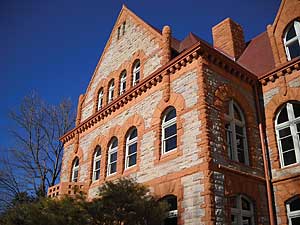
“We went around the building and looked at every stone,” said Rhonda Maas of
BRS. “We photographed just about every piece. We made plans and drawings
showing where the stone needed repairs and what needed to be done.” Photos courtesy of Building Restoration Specialties, Inc.
Assessing the stone
At the start of the restoration process, the team from BRS and Martin and Martin Engineering assessed every piece of sandstone. “We went around the building and looked at every stone,” said Maas. “We photographed just about every piece. Plans and specifications were made showing where the stone repairs were needed and what restoration technique needed to be applied.”One of the first steps taken in the restoration process was to clean the exterior facades. “There was staining all over the facade due to the age, weather and the stone deterioration,” said Maas. “We gave it a general cleaning. We didn’t make it look brand new. The goal was to just get the staining off of the stone and leave the historic patina.” Many pre-tests were conducted to determine the appropriate cleaning material and method, she went on to explain. “The desire was to use a cleaning solution that was less acidic,” said Maas. “We wanted something that didn’t open and etch the surface pores on the stone. The chemical we settled on was PROSOCO 766 Limestone Masonry Prewash and Afterwash and a 400 psi pressure washer for the rinsing procedure. Different degrees of stone patching were completed, as some stone pieces received epoxy injections. Some required their faces to be retooled and the majority of the water table stones required entire stone unit replacement.”
In addition to the cleaning and stone restoration, all of the mortar joints were cut out and replaced. “The mortar joints had eroded and cracked from weather, age and shifting stone elements requiring a total replacement,” said Maas. “A beaded joint was used at the stone and a slight weathered joint on the brick and terra-cotta joints. The original mortar was analyzed, so the cement, lime and aggregate ration could be matched. Several mock-ups were completed until the original colors were matched.”

As the foundation settled, the building’s weight
shifted and the stone in this arch sheared. BRS shored up the arch, repointed
the mortar and repaired the stone with a Dutchman patch.
Finding replacement sandstone
According to Maas, if a sandstone piece was patched, it was a very small repair. “We were trying to give a long-term fix, so epoxy patching was kept at a minimum and Dutchman repairs or replacement were the preferred repair methods,” she said. “In some cases, we tried to take an existing stone and use it where a smaller stone was required or we would install a total new replacement stone that was obtained through salvage. The quarry for this particular stone is no longer open, and besides, it is not really a great building stone. In restoring this building, the biggest challenge was finding a matching stone.”BRS was also fortunate to discover large blocks of salvaged sandstone from the demolition of other buildings from the same era as Treat Hall. “For years and years, they had been sitting in a salvage yard,” said Maas. “It was perfect for this project, and we certainly needed it. We purchased numerous pallets of stone, and we were able to carve the replacement pieces from these salvaged stones. It made it easier for us, because we were able to replace a lot.”
Additionally, BRS located Strid Marble and Granite Company in Cheyenne, WY, which quarries a stone that is a close match to the original sandstone. “There are tall peaks on the top of the building, and we didn’t have stone wide enough,” explained Maas. “We found a quarry in Wyoming that [yields] a more dense product that is a very close match in color. We used that on water ledges, caps and windowsills - anywhere there would be water accumulating.”
Treat Hall
Johnson & Wales UniversityDenver, CO
Owner: Johnson & Wales University, Denver, CO
Stone Restoration Specialist: Building Restoration Specialties, Inc. (BRS), Denver, CO
Stone Quarrier: Strid Marble and Granite Company, Cheyenne, WY (replacement sandstone)
Stone Restoration/Cleaning Product Manufacturer: PROSOCO, Inc., Lawrence, KS
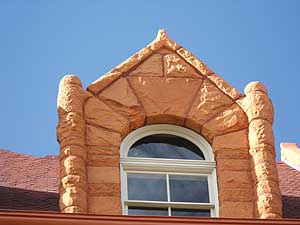
Due to the poor condition of the sandstone, many
pieces were replaced with matching stone quarried in Wyoming.
While a large portion of sandstone was replaced, there were some pieces that were salvaged. In addition to those that were patched, an epoxy injection was given to some stone pieces that had hairline/stress cracks.
A total of eight stonemasons were on the jobsite to restore Treat Hall. “We had a lead mason, Bryan Riggs, who had the most knowledge in stone carving,” explained Maas. “When extracting big pieces of stone out of a building, it is important not to lose the structure while popping a stone out. Installing strategically placed shoring is very important. Having an experienced staff is critical.”
In all, the $2.2 million project took two years to complete. At times, the restoration was halted due to cold weather during the winter months. According to Maas, the building has remained vacant since 1980, but once restoration of the interior is completed, it will house classrooms for the culinary school at Johnson & Wales University. The restoration project received support from the Colorado Historical Society State Historical Fund. A requirement for these grants is that the project “must demonstrate strong public benefit and community support.”
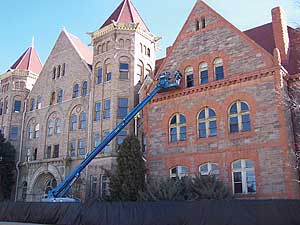
In addition to evaluating which stones could be repaired and which needed to be
replaced, the restoration specialists at BRS assessed how much the building has
shifted and the extent to which this had damaged the stones. Photos courtesy of Building Restoration Specialties, Inc.
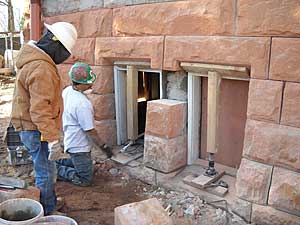
Crew members held the stone window frames in place while the stone in the
center support column was being replaced. Photos courtesy of Building Restoration Specialties, Inc.

BRS was fortunate to discover large blocks of salvaged
sandstone from the demolition of other buildings from the same era as Treat
Hall. “For years and years, they had been sitting in a salvage yard,” said Maas. “It was perfect for this project, and we certainly
needed it. We purchased numerous pallets of stone, and we were able to carve
the replacement pieces. It made it easier for us because we were able to
replace a lot.”
